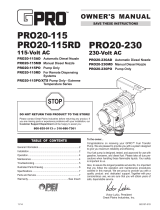
5
/ Warnings
Cooking Safety
• During use the appliance becomes hot. Care
should be taken to avoid touching heating
elements inside the oven.
• WARNING: Accesible parts may become very
hot during use. Young children should be kept
away.
• Once the unit has been installed as outlined
in the Installation Instructions, it is important
that the fresh air supply is not obstructed. The
use of the cooking appliance results in the
production of heat and moisture in the room in
which it is installed.
• Ensure that the kitchen is well-ventilated.
Keep natural venting holes open or install a
mechanical ventilation device. Prolonged or
intensive use of the appliance may call for
additional (such as opening a window) or more
eff ective ventilation (such as increasing the
level of a mechanical ventilation if present).
• NEVER use aluminum foil to cover oven racks
or oven bottom. This could result in risk of
electric shock, fi re, or damage to the appliance.
Foil can cause oven enamel to craze and /or
crack. Use foil only as directed in this guide.
• DO NOT heat unopened food containers,
build up of pressure may cause the container
to explode and result in injury.
• ALWAYS let quantities of hot fat used for deep
fat frying cool before attempting to move or
handle.
• DO NOT drape towels or materials on oven
door handles. These items could ignite and
cause burns.
• ALWAYS place oven racks in the desired
positions while oven is cool. Slide oven rack
out to add or remove food, using dry, sturdy
potholders.
• ALWAYS avoid reaching into the oven to add
or remove food. If a rack must be moved while
hot, use a dry pot-holder.
• ALWAYS turn the oven off at the end of
cooking.
• Use care when opening the oven door. Let
hot air or steam escape before moving or
replacing food.
• DO NOT cook directly on the oven bottom.
This could result in damage to your appliance.
Always use the oven racks when cooking in
the oven.
• Do not insert anything in the slots.
• Do not obstruct ventilation openings and heat
dispersal slots.
• In the event of breakage or cracking in the
glass, shut off the oven immediately and
disconnect it from the power supply. Contact
technical support.
• Sudden and extreme changes in temperature
can cause the glass to break – never pour
cold liquids onto the oven door.
• Using the oven generates heat and moisture –
keep the area well ventilated during operation.
• Never place fl ammable objects in the oven
• Do not open the door if smoke is coming
out of the oven. Shut the appliance off and
disconnect its power supply.
• Ensure that there are no trapped objects which
could prevent the oven door from shutting.
• The oven is not designed to operate with
timers or remote control systems.
• Plastic containers not designed for high
temperatures could melt, damaging the oven
or even catching fi re.
• Always use specifi c oven gloves for removing
or inserting heat-resistant cookware or
accessories.
• Appliance must not be installed behind a
decorative door in order to avoid overheating.
• Take great care when cooking food with a high
alcohol content, as this could cause a fi re.
• Remove any food residue from inside the oven
before using the appliance in order to prevent
fi res and smoking.
• After cooking, keep the door closed while the
oven is cooling down to prevent damaging
adjacent kitchen units.
• Fruit juice or any sugary liquids or syrups can
cause indelible staining; use deep dishes to
prevent leakage.
• Sugar/syrup that is not wiped off the enamel
surface can cause damage and/or permanent
stains to the enamel if subject to successive
cycles cookiong.
• Damaged containers, or those which are
unsuitably small, can lead to serious injuries.
• Do not operate the appliance with wet hands
or when it is in contact with water.
• Do not apply pressure to the open door.
• Do not use the appliance as a work surface
or shelf.
• Birds have very sensitive respiratory systems.
Keep pet birds out of the kitchen or other
rooms where kitchen fumes can reach them.
Recommended Utensils
• NEVER let a pan boil dry as this could damage
the utensil and the appliance.
• Follow the manufacturer’s directions when
using oven cooking bags.




















